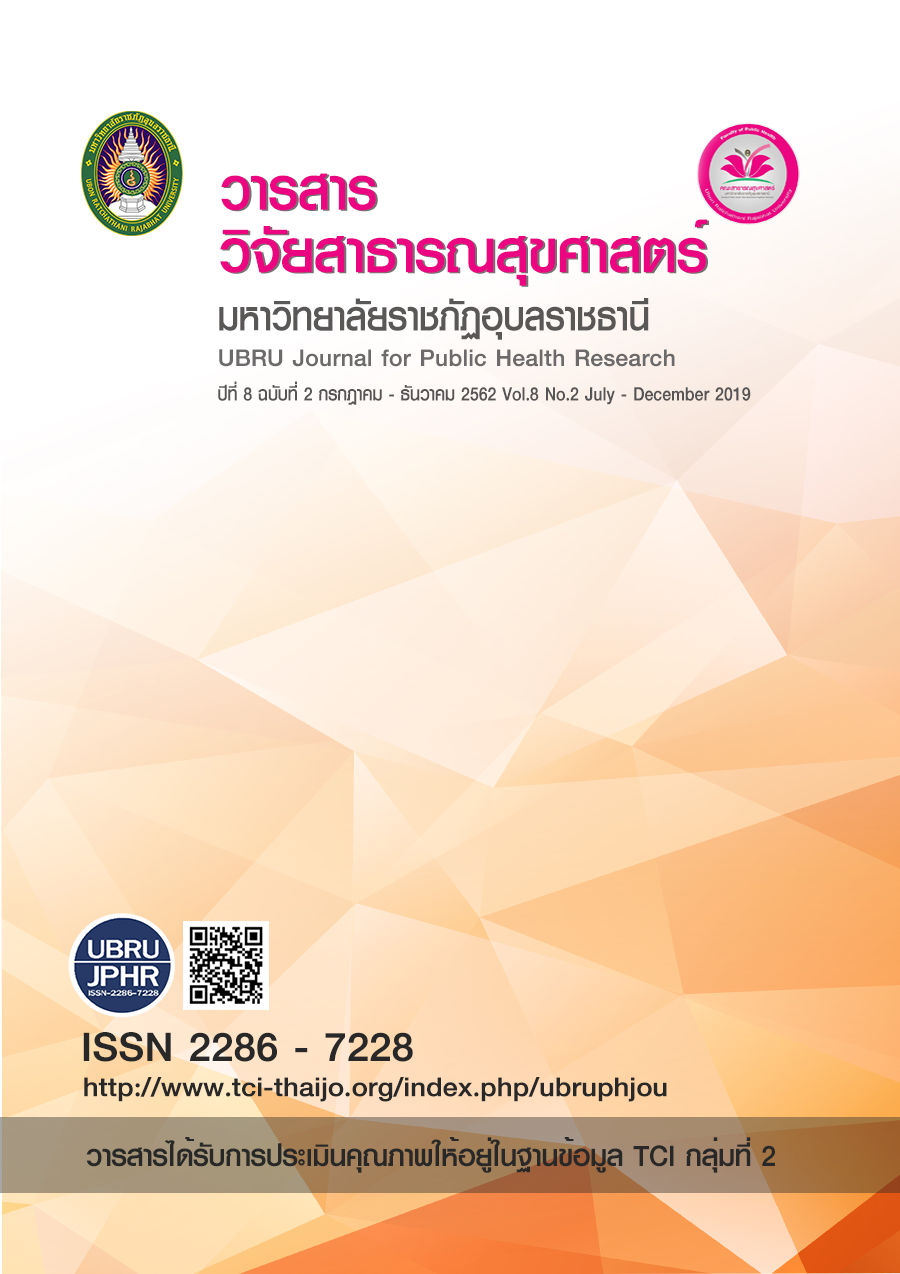Factors relating to receiving post exposure rabies vaccine among vaccine users: a case study in Kantharom District, Si Sa Ket Province
Keywords:
Rabies, WHO rabies exposure category, receiving post exposure rabies vaccineAbstract
This cross-sectional survey research aimed to examine factors related to receiving Post Exposure Rabies Vaccine among Vaccine Users in Kantharom District, Si Sa Ket Province. The 335 samples were randomly selected and interviewed by structure questionnaire.
The results show that 50.4% of people receiving rabies vaccine after exposure are female. The average age is 44.46 years old. Most of them (54.3%) are married. In terms of education, 35.2% of them were graduated from high school. Most of them (32.8%) are farmers and the average income is 7,198.31 baht. 30.1% of the samples are in the 30-Baht Welfare Scheme. The average distance from home to hospital is 11.12 km. The kind of animals that they were mostly exposed to is dogs (77.6%) and 73.4% of them did not know the history of rabies vaccination of the animals. Most of the patients receiving the service (62.4%) were in the WHO rabies exposure category3. The knowledge, attitude, perception of rabies and Reinforcing factors of the patients were in moderate level. Enabling factors of the patients were in high level. The factor related to vaccine adherence that is statistically significant is knowledge (c2=9.276, p<0.05). The statistically significant factors related to cleaning of Post-exposure wounds include sex, age, education, occupation, income, medical welfare scheme, kind of animal exposed to, WHO rabies exposure category, knowledge, attitude and Reinforcing factors.
This research suggests that people should be educated about rabies, with emphasis on the species of animals that can be infected with the disease and the need to trap the animals after exposure. Furthermore, people should know that they can reduce the amount of germs entering the body by washing the wound.
References
โกวิท คัมภีรภาพ. (2560). โรคพิษสุนัขบ้า. วารสารกรมการแพทย์. 42(5), 10-13.
ชนากานต์ บุญนุช และยุวดี เกตสัมพันธ์. (2554). ขนาดกลุ่มตัวอย่างในงานวิจัยเชิงปริมาณ. กรุงเทพฯ: เอกสารชุมชนนักปฏิบัติติ คณะแพทยศาสตร์ศิริราชพยาบาล มหาวิทยาลัยมหิดล.
ปรารถนา วัชรานุรักษ์ และอัจฉรา กลับกลาย. (2560). ปัจจัยที่มีอิทธิพลต่อพฤติกรรมการป้องกันโรคในผู้ป่วยกลุ่มเสี่ยงโรคหลอดเลือดสมอง จังหวัดสงขลา. วารสารเครือข่ายวิทยาลัยพยาบาลและการสาธารณสุขภาคใต้. 4(1), 217-233.
ผาณิต แต่งเกลี้ยง. (2557). ปัจจัยที่มีความสัมพันธ์กับการฉีดวัคซีนไม่ครบตามนัดของผู้สัมผัสโรคพิษสุนัขบ้า โรงพยาบาลพรหมคีรี อำเภอพรหมคีรี จังหวัดนครศรีธรรมราช. นครศรีธรรมราช: โรงพยาบาลพรมคีรี.
ระบบสารสนเทศเพื่อการเฝ้าระวังโรคพิษสุนัขบ้า (THAI RABIES NET). สำนักควบคุม ป้องกันและบำบัดโรคสัตว์. [ออนไลน์]. ได้จากhttps://www.thairabies.net/trn/Default_Main.aspx. Accessed 19 February 2018. [สืบค้นเมื่อ 19 กุมภาพันธ์ 2561]
โรงพยาบาลบ้านตาก. (2559). การศึกษาเรื่องลักษณะของผู้สัมผัสหรือผู้สงสัยว่าสัมผัสโรคพิษสุนัขบ้าอำเภอบ้านตาก จังหวัดตาก ปีงบประมาณ 2559. [ออนไลน์]. ได้จาก https://bantakhospital.go.th/file/94479964020170118_232126.pdf. [สืบค้นเมื่อ 19 กุมภาพันธ์ 2561]
วันชัย เยี่ยงกุลเชาว์. (2558). ปัจจัยที่มีความสัมพันธ์กับพฤติกรรมส่งเสริมสุขภาพของครอบครัว ในพื้นที่รับผิดชอบของโรงพยาบาลส่งเสริมสุขภาพตำบลบ้านช้าง จังหวัดนครศรีธรรมราช. [ออนไลน์]. ได้จาก https://www.vcharkarn.com/blog/118108. [สืบค้นเมื่อ 9 มีนาคม 2561]
สุดา สีบุญเรือง และธีระพงษ์ ตัณฑวิเชียร. (2553). เวชปฏิบัติในการดูแลรักษาผู้ป่วยที่ถูกสัตว์กัดและการป้องกันโรคพิษสุนัขบ้า. กรุงเทพฯ:สภากาชาดไทย.
สุนทรี ใจมีธรรม. (2543). พฤติกรรมการป้องกันโรคพิษสุนัขบ้าของผู้มารับบริการฉีดวัคซีนป้องกันโรคพิษสุนัขบ้าในสถานบริการสาธารณสุข จังหวัดเพชรบุรี. กรุงเทพฯ: มหาวิทยาลัยศรีนครินทรวิโรฒ ประสานมิตร.
สำนักงานป้องกันควบคุมโรคที่ 7 จังหวัดขอนแก่น. [ออนไลน์]. ได้จาก https://odpc7.ddc.moph.go.th/archives. [สืบค้นเมื่อ 11 กุมภาพันธ์ 2561]
อภิรมย์ พวงหัตถ์. (2559). แนวทางเวชปฏิบัติโรคพิษสุนัขบ้าและคำถามที่พบบ่อย. นนทบุรี: กรมควบคุมโรคกระทรวงสาธารณสุข.
อภิรมย์ พวงหัตถ์ วิรงรอง หุ่นสุวรรณ และปราณี พาณิชย์พงษ์. (2552). แผนยุทธศาสตร์โครงการสัตว์ปลอดโรคคนปลอดภัยจากโรคพิษสุนัขบ้าให้หมดไปจากประเทศไทยภายในปี 2563. นนทบุรี: กรมควบคุมโรค กระทรวงสาธารณสุข.
Marshall H. Becker and Lois A. Maiman. (1975). Sociobehavioral Determinants of Compliance with Health and Medical Care Recommendations Medical Care. Journal article. 13(1), 10-24.
Green, L. W., & Kreuter, M. W. (1991). Health Promotion Planning. Mountain View: Mayfield Publishing.
Rabies vaccines and immunoglobulins: WHO position. [online]. Available from: https://www.who.int/neglected_diseases/news/Rabies_WHO_has_published_new_recommendations_for_immunization/en/. [cited 14 July, 2018]
Downloads
Published
How to Cite
Issue
Section
License
เนื้อหาและข้อมูลในบทความที่ลงตีพิมพ์ในวารสารวารสารวิจัยสาธารณสุขศาสตร์ มหาวิทยาลัยราชภัฏอุบลราชธานี ถือเป็นข้อคิดเห็นและความรับผิดชอบของผู้เขียนบทความโดยตรงซึ่งกองบรรณาธิการวารสาร ไม่จำเป็นต้องเห็นด้วย หรือร่วมรับผิดชอบใดๆ
บทความ ข้อมูล เนื้อหา รูปภาพ ฯลฯ ที่ได้รับการตีพิมพ์ในวารสารนี้ ถือเป็นลิขสิทธิ์ของวารสารฯ หากบุคคลหรือหน่วยงานใดต้องการนำทั้งหมดหรือส่วนหนึ่งส่วนใดไปเผยแพร่ต่อหรือเพื่อกระทำการใดๆ จะต้องได้รับอนุญาตเป็นลายลักอักษรณ์จากบรรณาธิการวารสารนี้ก่อนเท่านั้น


